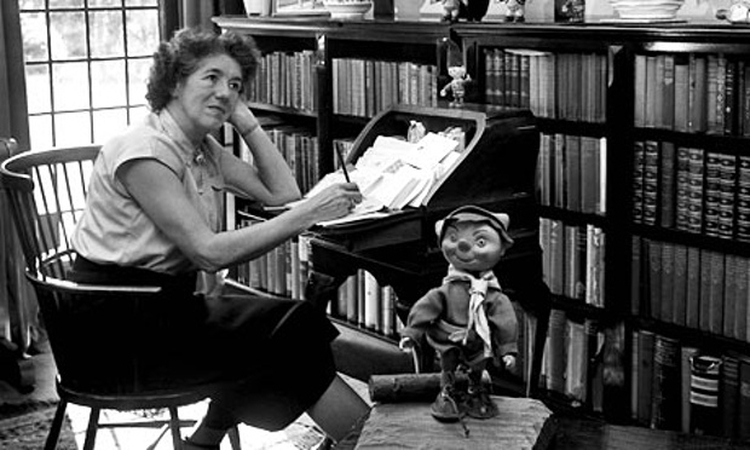Over the last few decades the word “racist” has become almost synonymous with Enid Blyton’s name. Accusations of sexism and classism have also persisted, along with the BBC’s recent desperate campaign to expose her personal life and “shock” us all with sordid tales of her adultery and bad motherhood, presenting her as a raving racist lunatic who hung about weeping in cupboards. Enid certainly was xenophobic. Enid disliked travelling and one trip to America put paid to foreign excursions. She casually used the word “N****r” to name Gollys and dogs. Her villains were bland, faceless “foreign” men in some of her adventure stories. The French girls at boarding school did not have the same “sense of honour” as the English girls, but always came good in the end; the Americans were brash and bold and annoying and did things unbefitting to schoolgirls such as wearing lipstick. And she frequently used Golliwogs in her stories. There is no denying that some of Enid’s books, published from the 1920s to the 1960s, perpetuated racial stereotypes. However, Enid’s books were not initially banned for being racist. Far from it. Enid’s books display the careless sort of xenophobia typical of her time, especially in the war era, and present in many, many children’s books of the first half of the 20th century. What Enid was really banned for was being too popular.
It was the BBC who launched the anti-Blyton campaign. In an internal memo from 1938, almost two decades in to Enid’s prolific career, Head of the BBC schools department Jean Sutcliffe said that her stories:
“might do for children’s hour but certainly not for schools dept they haven’t much literary value – but are competently written without sentimentality on the whole[…]There is rather a lot of the Pinky-winky-Doodle-doodle Dum-dumm type of name (and lots of pixies) in the original tales – and in the nature study tales a very animistic tendency and no feeling for the true characteristics of different animals”.1
Incidentally Enid’s nature books and country settings inspired her young readers to investigate nature, and they sent her many parcels containing things such as posies of wild flowers, small insects in match boxes and even a dead bird was sent along for Enid to identify.2
Enid tried appealing to the Children’s Hour director, sending a letter and three books to the BBC in July of 1940.3 In August her play The Monkey and the Barrel-Organ was rejected for the Children’s Hour radio programme, with an internal memo dismissing it as: “not really good enough. Very little happens and the dialogue is so stilted and long-winded.” with a second note adding that “It really is odd to think that this woman is a best-seller. It is all such very small beer”.4
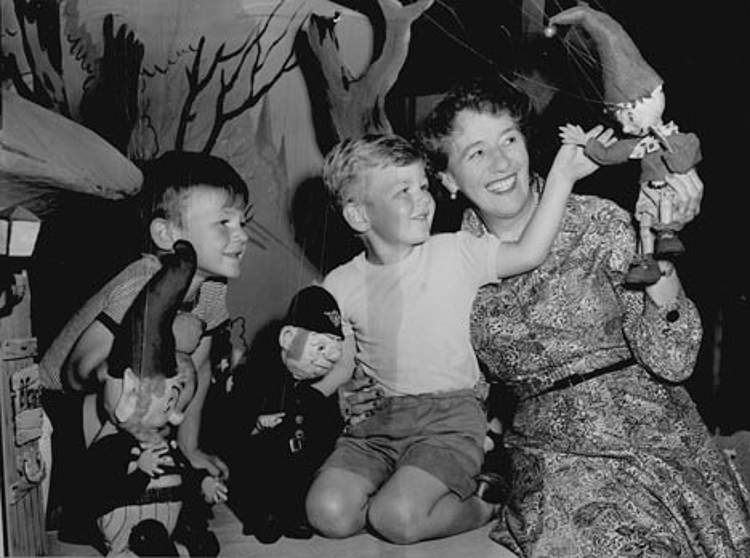
Enid herself was aware of the ban, telling BBC producer Lionel Gamlin, who wanted to interview her that:
“I ought to warn you of something you obviously don’t know, but which has been well-known in the literary and publishing world for some time – I and my stories are completely banned by the B.B.C. as far as children are concerned – not one story has ever been broadcast, and, so it is said, not one ever will be.” 5
Jean Sutcliffe was nothing if not tenacious. In 1954, sixteen years after Sutcliffe first banished Enid, Janet Quigley, editor on the Woman’s Hour, told her that:
“We are frequently asked by listeners to Woman’s Hour why we never invite Enid Blyton to speak as a Guest of the Week or on some subject connected with writing for children. Several of the producers who work for me on the programme do not share my own views about Enid Blyton and feel that whatever we may think of her books we are being rather stuffy and dictatorial in not allowing listeners to hear somebody whose name is a household word.”6
Sutcliffe was not to be deterred, replying:
“it is debatable whether it is fair to keep her out of the sort of programme you suggest if there is a demand from the audience to get into closer touch with this well-known personality. In my view if the invitation is simply to meet her and she be asked to give her views on Horror comics or Hats or anything under the sun except her own methods and aims in writing for children – no harm could be done. But if she is allowed to lay down the law on aims and methods of writing for children – unchallenged by really good writers or parents and educationalists of wide and deep experience in the field of children’s literature, the BBC becomes just another victim of the amazing advertising campaign which has raised this competent and tenacious second-rater to such astronomical heights of success.”
“No writer of real merit could possibly go on believing that this mediocre material is of the highest quality and turn it out in such incredible quantities. Her capacity to do so amounts to genius and it is here that she has beaten everyone to a standstill. Anyone else would have died of boredom long ago.”7
Enid did not appear on the Women’s Hour until 1963, just five years before her death.
Noddy Gets Into Trouble
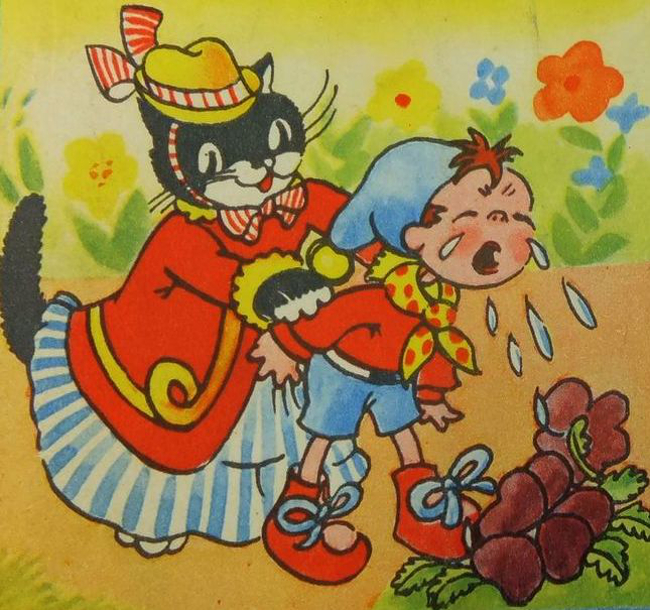
The anti-Blyton campaign of the ‘fifties and ‘sixties centred around one of the most famous children’s characters of all time, Noddy. A collaboration between Enid and children’s illustrator Harmsen Van Der Beek, Noddy and his Toyland friends were an instant hit, hugely popular with children and became such a demanding project that Harmsen confessed that when he was working through into the early hours to meet a deadline, ‘Little Noddies’ would appear from everywhere and crawl all over his desk.8 With hundreds of books already published, librarians were becoming sick of Enid’s books dominating the shelves, claiming that, with Enid’s prolific output “it was quite possible for children to be introduced to one or another of Enid’s books at the age of two or three and read no other author until they progressed ‘if ever, on such a spoon-fed diet’ to adult literature. Stories of greater depth and characterisation, of which there was now a wide range, were thus being ignored.”9 By the end of the ‘fifties scarcely a day passed without the anti-Blyton propaganda machine appearing in one newspaper or another.10
The librarians did not stop at removing books from shelves. The rumours that Enid did not write her own books began to gain momentum. In 1955 a reader’s mother attended a parents’ meeting at her daughter’s school at which the speaker, a young librarian, implied that Enid did not write her own books. Enid wrote to her solicitor:
“This is very damaging, not only to my books, but to me. I am such a public figure now, and well trusted, as you know, and run many clubs and societies which bring in money, that I absolutely must have these rumours cleared up – for who is going to believe I am honest if I don’t even write my own books! … In the last month or two we have had rumours from Australia that I am dead and someone else is writing my books. Rumours from S. Africa that I am dead and no longer write my books and rumours, also from S. Africa, that I am alive, but do not write my books and now here is a librarian with the same slander …”11
After legal action, the librarian was forced to apologise the following year, but the rumours persisted as Enid continued with her usual staggering output. Happily, the banning of her books from libraries merely resulted in increased sales, especially when the affordable paperback copies of her books were introduced in the early ‘sixties.
Colin Welch’s Dear Little Noddy: A Parent’s Lament in Encounter12 magazine in 1958 is even more revealing of adult’s attitudes towards Enid. While, these days, many happily quote the description of Noddy as “the most egocentric, joyless, snivelling and pious anti-hero in the history of British fiction” (this is not actually said in Welch’s 1958 Encounter article), no one seems to address the article itself. The article opens with Welch complaining he has to read Noddy to his children, launching into a half-page tally of Noddy book and merchandise sales, then describing Enid as a “former school teacher” rather than an author, despite the fact Enid had been writing full-time for more than three decades at that point. Welch says her output “naturally” aroused suspicion, then complains that she “must be the highest paid woman in the British Isles” and, taking a sarcastic jab at Enid’s earnest ways, crowing that “she has A Message”. He then mentions Noddy sales yet again (the third time in the first page and a half of the article). If you haven’t picked up on the preoccupation by now, it is that a woman writing simple stories for children has dominated a male market and become not only successful, but independently wealthy. Being a female and not accepted by the intellectually elite, she must be squashed.
Welch then goes on to say that Enid writes down to her readers, and that the books failed to stretch their imagination; “By putting everything within reach of the child mind, they enervate and cripple it”, before dropping an outrageous reference to Christopher Craig, a sixteen year-old boy who killed a police officer in 1952, “of whom at his trial for murder, it was stated that “the only books he knows anything about are the books of Enid Blyton, which he gets other people to read for him.” Then espousing the Victorian propaganda that children had no books before the Victorian era, Welch gushes that “Victorian children’s books often involve long words and quite complex intellectual and moral problems” and quotes ‘the acid comment of a town librarian’ that “Only not-so-bright children like Enid Blyton”.
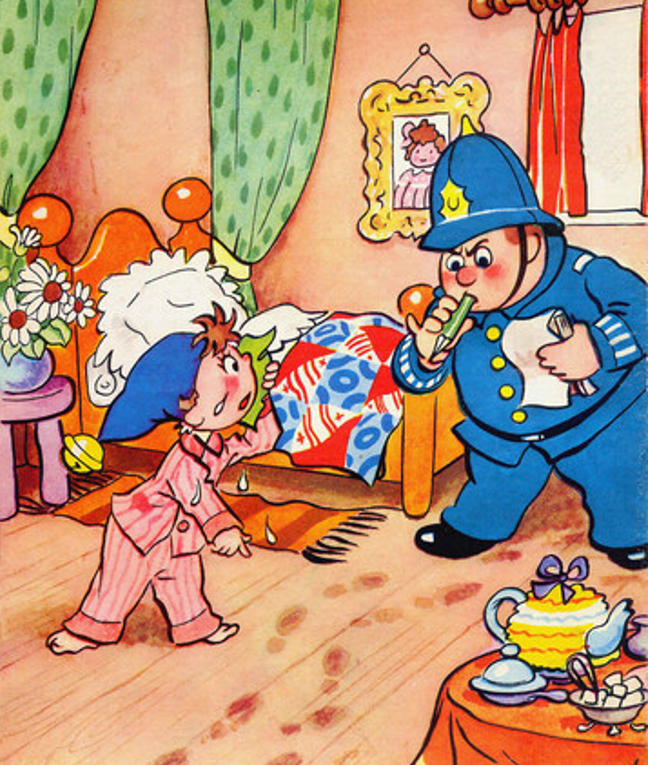
While Welch is forced to admit that “bright and not-so-bright” children enjoyed Blyton books it is clear that Noddy is the target of his ire, and a three page attack on the little wooden doll follows. Welch then sets the tone by rather ingeniously comparing Noddy’s songs to Richard Wagner’s creative process, “Miss Blyton is equally intrepid”, inferring that Blyton too must be an anti-Semite. Over the next few pages Welch tell us that Noddy’s “imbecility is almost indecent”, calls his nodding head a “palsy or Saint Vitus Dance (Sydenham’s chorea)“, and claims that “in the light of Noddy’s manifest feeble-mindedness it is bound to acquire a deeper and more sinister significance. One recalls Zinsser’s description of St. John’s Evil, a mediaeval scourge in which whole villages, driven mad by want and misery, went about shaking and nodding.” He then goes on to diagnose that “More striking even than Noddy’s imbecility is his timidity, which again borders on the pathological.”, complaining that Noddy is terrified of everything. Noddy is “utterly resourceless”, “querulous, irritable and humourless”, “unnaturally priggish” and “a sneak”. “In this witless, spiritless, snivelling, sneaking doll the children of England are expected to find themselves reflected” is Welch’s anguished cry; for what could be more truly terrible than a woman and a sensitive little wooden boy prone to tears dominating the children’s book market?13
Noddy and the Homophobes
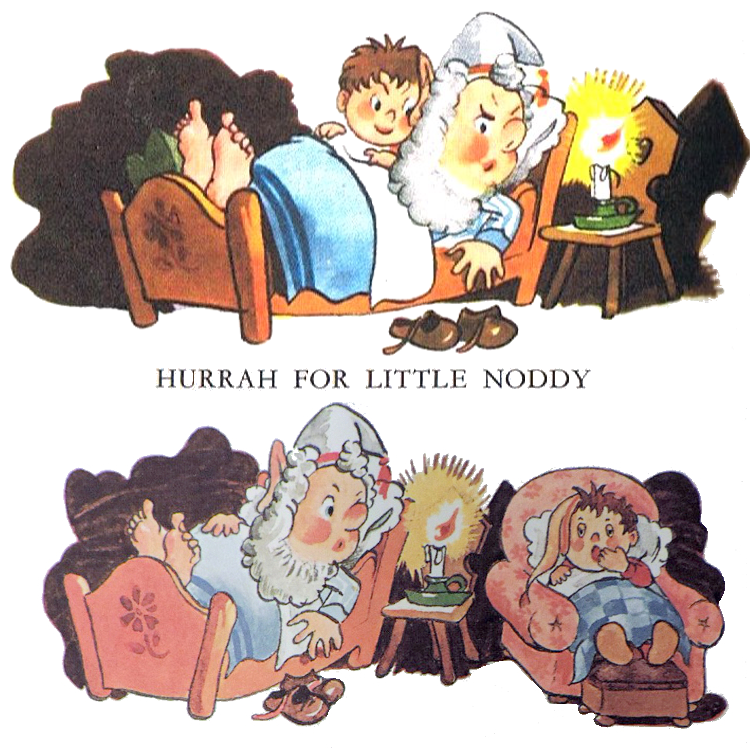
The idea of a ‘suspect’ relationship between Noddy and Big Ears has no clear origins, but the “talking down” to children that Welch kept moaning about cannot be ruled out, on behalf of Enid’s critics rather than Enid herself. Talking down to readers is, in fact, more common today with the bowdlerising of classic books and the peculiar need of the American publishing industry to ‘Americanise’ English in children’s books. Literary criticism can lack a nuanced grasp of history, but the sharing of beds in the early 20th century was perfectly common, and sharing of rooms only went out of fashion a couple of decades ago. Therefore, there should be no room for confusion. Siblings and friends of the same gender sharing beds was expected, and siblings of different genders often shared a nursery. The original scene in Hurrah for Little Noddy! showed Noddy and Big ears getting into bed together and said:
They had their cups of cocoa and a chocolate biscuit each. Then they squashed into Big Ears’ tiny, soft, bed, put their arms around one another to stop from rolling out, and fell asleep.
The edited image shows Noddy falling asleep in an armchair and now says:
They had their cups of cocoa and a chocolate biscuit each. Then they climbed into bed and fell asleep.
In a recent BBC adaptation of The Go-Between, two young boys are shown sharing a bed in an enormous mansion that had plenty of spare rooms. Clearly the film-makers wanted to retain historical accuracy and saw no reason to sexualise the act of two children sharing a bed. Why sexualising children is acceptable in literary criticism is a complete mystery. Surely those who rally against young children being sexualised because of consumerism and advertising should refrain from sexualising children’s friendships; therefore making children associate innocent affection with sex and guilt.
The Fate of Mr. Golly

Gollies have been causing fierce debate for decades. Created by Florence Kate Upton, “Golliwogg” first appeared in the 1895 children’s book The Adventure of Two Dutch Dolls and a ‘Golliwogg’, illustrated by by Bertha Upton, and it is not hard to see why he captured the hearts of readers.
At first he frightens the Dutch Dolls.
Then all look round, as well they may
To see a horrid sight!
The blackest gnome
Stands there alone,
They scatter in their fright.With kindly smile he nearer draws;
Begs them to feel no fear.
“What is your name?”
Cries Sarah Jane;
“The ‘Golliwogg’ my dear.
Soon the dolls are flirting with Golliwogg, trying to charm him with ‘small talk’ and ‘sidelong glances’.
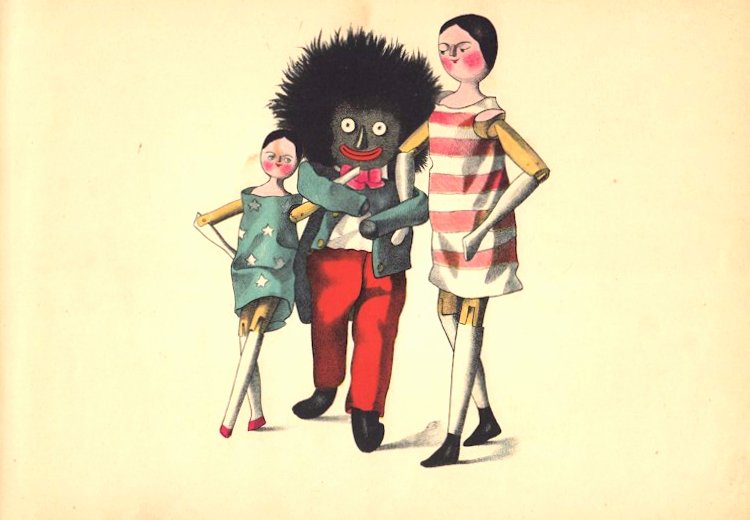
The book features a multicultural cast, representing ‘dolls of the world’ with black female doll, a ‘Jovial African’ who dances with Sarah Jane, and watches a “Magnate” from Japan with her. The ‘Jovial African’ later dances with a Chinese doll. Another black minstrel doll, Sambo, turns up to sing a song. Peg and Sarah Jane, for their part, are devoted to their new friend. They run away to play in the snow and Golly pays them out for throwing snowballs at him.
“Vengeance!” he cries, “I’ll pay them out!
If girls will play with boys,
There’s got be
Equality
So here’s for equipoise!”
The girls later fish him out of a frozen lake and carry him home. Golliwogg was an instant hit, with another twelve books written from 1896 to 1909. Golliwog dolls became immensely popular, and as Upton did not trademark the character, the name became generic.
The problem with Golliwogs, of course, is that the image is based on minstrels, a 19th century popular American entertainment that parodied and denigrated African Americans. The Golly wore similar clothes to a minstrel, and a minstrel perpetuated racist stereotypes. There is no denying that. But many children, especially 20th century children, had no idea of the origins of Gollies, and indeed, why should they? Many wouldn’t make that association until they were much older. In Dr. Paul Rudd’s Enid Blyton and the Mystery of Children’s Literature, he notes that “of the children who were not previously aware of the equation ‘golliwog equals ethnically black person’, none made it”. By and large, outside America, Golliwogs were considered dolls.
Enid Blyton said much the same when pressed about the Toyland Golliwogs perpetuating racial stereotypes.
“Golliwogs are merely lovable black toys, not Negroes. Teddy bears are also toys, but if there happens to be a naughty one in my books for younger children, this does not mean that I hate bears!”
The controversy arose over Here Comes Noddy Again, which featured four naughty Golliwogs stealing Noddy’s taxi. As Enid pointed out, her books featured many more naughty goblins and pixies than Golliwogs. But she was not insensitive to changing social values. During her lifetime steps were being made to remove offensive terms, the Gollies, Golly, Woggy and N****r, were renamed Wiggie, Waggie, and Wollie, and the word “N****r” removed from two other books where it had been used to name dogs. However, the accusations of racism would not abate. The Gollies were eventually replaced by goblins.
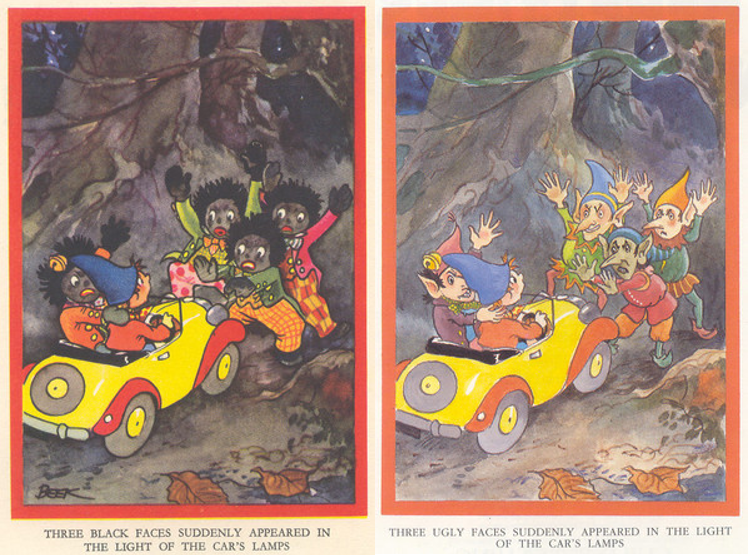
And proud Mr. Golly was next. The owner of the Toyland garage, Mr. Golly was rather more prosperous than the book’s main hero, and an important member of Toyland. At least the BBC replaced him with a black female doll in the television series, rather than the white male Mr. Sparks that replaced him in the book.
Today you can buy brand new copies of Florence K. Upton‘s The Adventure of Two Dutch Dolls and a ‘Golliwogg’, and Helen Bannerman’s Little Black Sambo with the original images. But you’ll never see a Golliwog in an Enid Blyton book again. Which really does display the bias towards Enid’s success. The Adventure of Two Dutch Dolls and a ‘Golliwogg’ and Little Black Sambo might be considered cultural artefacts, but Enid is still considered racist.
Unfortunately for the anti-Blytons you can no longer call Enid’s books racist. Many are being reprinted with all sorts of changes and updates to reflect modern attitudes and values and children still continue to enjoy them. They would be horrified that she has sold more than six hundred million books to date. And so Noddy got his revenge on his oppressors.
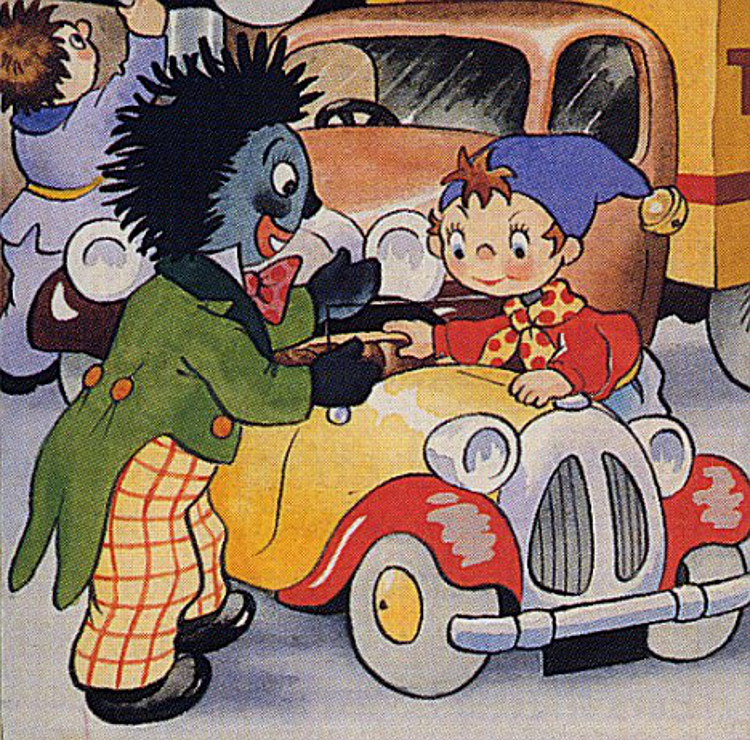
- “Enid Blyton and the BBC: Revealing the writer’s troubled relationship with the BBC”, BBC Archive, <http://www.bbc.co.uk/archive/blytonandthebbc/> (accessed September 2016) ↩
- Stoney, Barbara, Enid Blyton: The Biography, The History Press, 2011, (eBook) pp. 155 ↩
- “Enid Blyton and the BBC: Revealing the writer’s troubled relationship with the BBC” ↩
- Ibid ↩
- Ibid ↩
- Ibid ↩
- Ibid ↩
- Stoney, Barbara, Enid Blyton: The Biography, The History Press, 2011 (eBook) pp. 458 ↩
- Ibid pp. 311 ↩
- Ibid ↩
- Ibid pp.316 ↩
- Welch, Colin, “Dear Little Noddy: A Parent’s Lament”, Encounter, 1958, pp. 18-22 ↩
- All quotes from: Welch, Colin, “Dear Little Noddy: A Parent’s Lament”, Encounter, 1958, pp. 18-22 ↩

